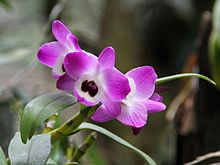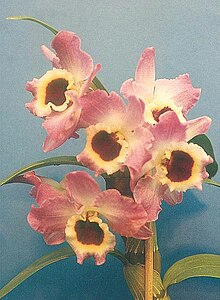| Dendrobium nobile | |
|---|---|

| |
| Scientific classification | |
| Kingdom: | Plantae |
| Clade: | Tracheophytes |
| Clade: | Angiosperms |
| Clade: | Monocots |
| Order: | Asparagales |
| Family: | Orchidaceae |
| Subfamily: | Epidendroideae |
| Genus: | Dendrobium |
| Species: | D. nobile
|
| Binomial name | |
| Dendrobium nobile | |
| Synonyms[3] | |
| |
Dendrobium nobile, commonly known as the noble dendrobium, is a member of the family Orchidaceae. Dendrobium nobile is one of the most widespread ornamental members of the orchid family. It is the state flower of Sikkim, a pradesh in India.[4][5]
Description
[edit]
Dendrobium nobile is a sympodial orchid that forms pseudobulbs. When the mother plant's life cycle ends, it produces offsets, continuing the plant's life. The new plant then repeats this cycle. Its inflorescence is erect, with blooms forming along the length of the flowering stem. It has strap-shaped, persistent leaves and blooms mostly in winter and spring, producing short, 2 to 4-flowered racemes. The flowers are fragrant, waxy, and highly variable in color, ranging from white to pink and purple. The many different cultivated varieties produce blooms of different sizes and colors.[6]
Distribution
[edit]Dendrobium nobile is an epiphytic or lithophytic plant native to southern China (including Tibet), the Himalayas (India, Bangladesh, Assam, Nepal, Bhutan), and Indochina (Myanmar, Thailand, Laos, Vietnam).[7][8][9][10][11][12][13] The species is also reportedly naturalized in Hawaii.[14] Dendrobium nobile occurs in lowland and mountain forests, often on mossy limestone rocks.
Pharmacology
[edit]Extract of the stems of Dendrobium nobile yielded 17 phenanthrenes (including 3,4,8-trimethoxyphenanthrene-2,5-diol, 2,8-dihydroxy-3,4,7-trimethoxyphenanthrene, 3-hydroxy-2,4,7-trimethoxy-9,10-dihydrophenanthrene, 2,8-dihydroxy-3,4,7-trimethoxy-9,10-dihydrophenanthrene, 2-hydroxy-4,7-dimethoxy-9,10-dihydrophenanthrene, 2,2'-dihydroxy-3,3',4,4',7,7'-hexamethoxy-9,9',10,10'-tetrahydro-1,1'-biphenanthrene and 2,3,5-trihydroxy-4,9-dimethoxyphenanthrene).[15][16] There have been many studies on the complex chemistry of the plant.[vague]
Usage
[edit]It is also one of the 50 fundamental herbs used in traditional Chinese medicine, known as shí hú (Chinese: 石斛) or shí hú lán (Chinese: 石斛兰).[17]
Dendrobium nobile has been added to the EU novel foods catalogue as it is deemed unsafe for human consumption within food supplements without a safety assessment.[18]
Cultivation
[edit]It has become a popular cultivated decorative house plant, because it produces colourful blooms in winter and spring, at a time when little else is in flower. It is a tender plant that only survives winters in USDA hardiness zones 11 and above.[19]
Examples of the species are grown in Kew Gardens Tropical Nursery in London and seeds are stored in the Millennium Seed Bank there.[citation needed]
See also
[edit]- Dendrobine, a toxin found in Dendrobium nobile
References
[edit]- ^ "Appendices I, II and III". Convention on International Trade in Endangered Species of Wild Flora and Fauna. 14 October 2010. Retrieved 20 December 2019.
- ^ "Dendrobium nobile". Germplasm Resources Information Network. Agricultural Research Service, United States Department of Agriculture. Retrieved 5 February 2008.
- ^ "Dendrobium nobile". Plants of the World Online. Board of Trustees of the Royal Botanic Gardens, Kew. 2017. Retrieved 20 December 2020.
- ^ "States and Union Territories Symbols". knowindia.gov.in. Archived from the original on 12 November 2013. Retrieved 13 June 2016.
- ^ "Flora and Fauna". sikkimtourism.gov.in. Archived from the original on 17 April 2016. Retrieved 13 June 2016.
- ^ "Dendrobium nobile in Flora of China @ efloras.org". eFloras.org Home. Retrieved 9 May 2024.
- ^ Kew World Checklist of Selected Plant Families
- ^ Flora of China v 25 p 381, 石斛 shi hu, Dendrobium nobile Lindley, Gen. Sp. Orchid. Pl. 79. 1830.
- ^ Wood, H.P. (2006). The Dendrobiums: 1-847. A.R.G. Gantner Verlag K.G., Ruggell.
- ^ Lucksom, S.Z. (2007). The orchids of Sikkim and North East Himalaya: 1-984. S.Z.Lucksom, India.
- ^ Huda, M.K. (2007). An updated enumeration of the family Orchidaceae from Bangladesh. The Journal of the Orchid Society of India 21: 35-49.
- ^ Raskoti, B.B. (2009). The Orchids of Nepal: 1-252. Bhakta Bahadur Raskoti and Rita Ale.
- ^ Choudhary, R.K., Srivastava, R.C., Das, A.K. & Lee, J. (2012). Floristic diversity assessment and vegetation analysis of Upper Siang district of eastern Himalaya in North East India. Korean Journal of Plant Taxonomy 42: 222-246.
- ^ Ackerman, J.D. (2012). Orchids gone wild. Discovering naturalized orchids in Hawaii. Orchids; the Magazine of the American Orchid Society 81: 88-93.
- ^ Hwang, Ji Sang; Lee, Seon A; Hong, Seong Su; Han, Xiang Hua; Lee, Chul; Kang, Shin Jung; Lee, Dongho; Kim, Youngsoo; Hong, Jin Tae; Lee, Mi Kyeong; Hwang, Bang Yeon (2010). "Phenanthrenes from Dendrobium nobile and their inhibition of the LPS-induced production of nitric oxide in macrophage RAW 264.7 cells". Bioorganic & Medicinal Chemistry Letters. 20 (12): 3785–7. doi:10.1016/j.bmcl.2010.04.054. PMID 20483604.
- ^ Yang, H; Sung, S. H; Kim, Y. C (2007). "Antifibrotic phenanthrenes of Dendrobium nobile stems". Journal of Natural Products. 70 (12): 1925–9. doi:10.1021/np070423f. PMID 18052323.
- ^ Berger, Markus (28 May 2018). "Ethnobotanik: Dendrobium nobile – Eine berauschende Orchidee". www.grow.de (in German). Retrieved 27 January 2023.
- ^ "Dendrobium nobile". European Commission. Archived from the original on 2 April 2015. Retrieved 30 August 2019.
- ^ "Care of Nobile Orchid Dendrobium".
External links
[edit] Media related to Dendrobium nobile at Wikimedia Commons
Media related to Dendrobium nobile at Wikimedia Commons- Dendrobium nobile List of Chemicals (Dr. Duke's Databases) Archived 26 January 2022 at the Wayback Machine
- National orchid societies which give advice about the cultivation of Dendrobium nobile and other orchid species include: